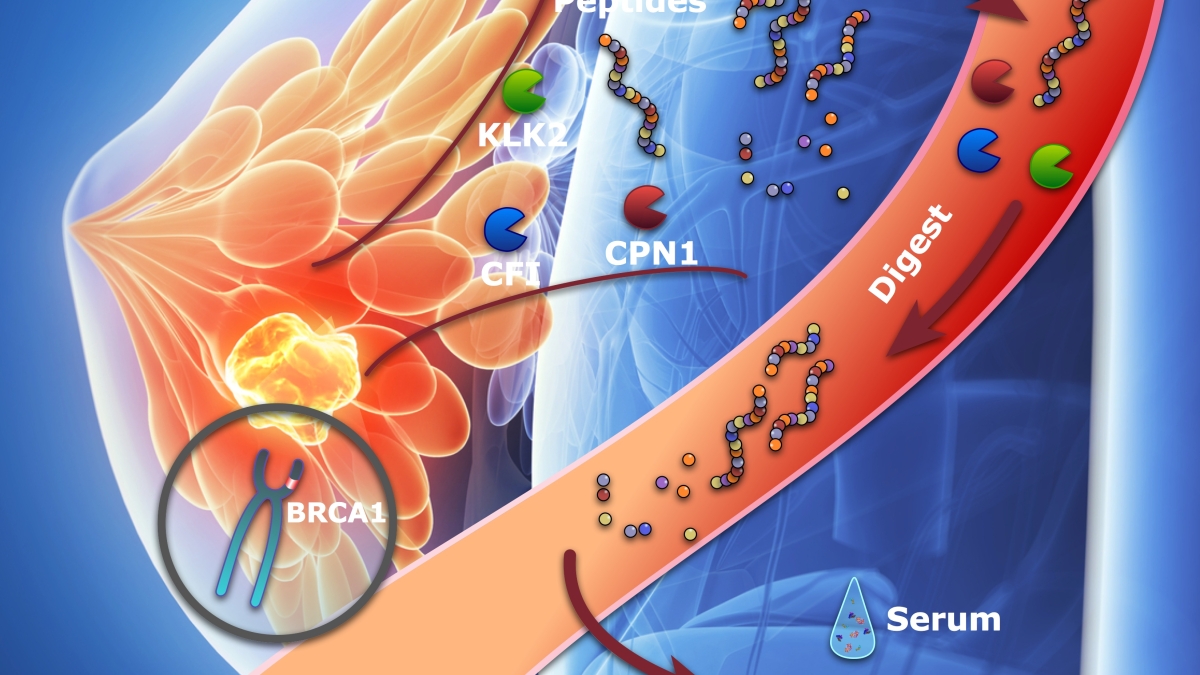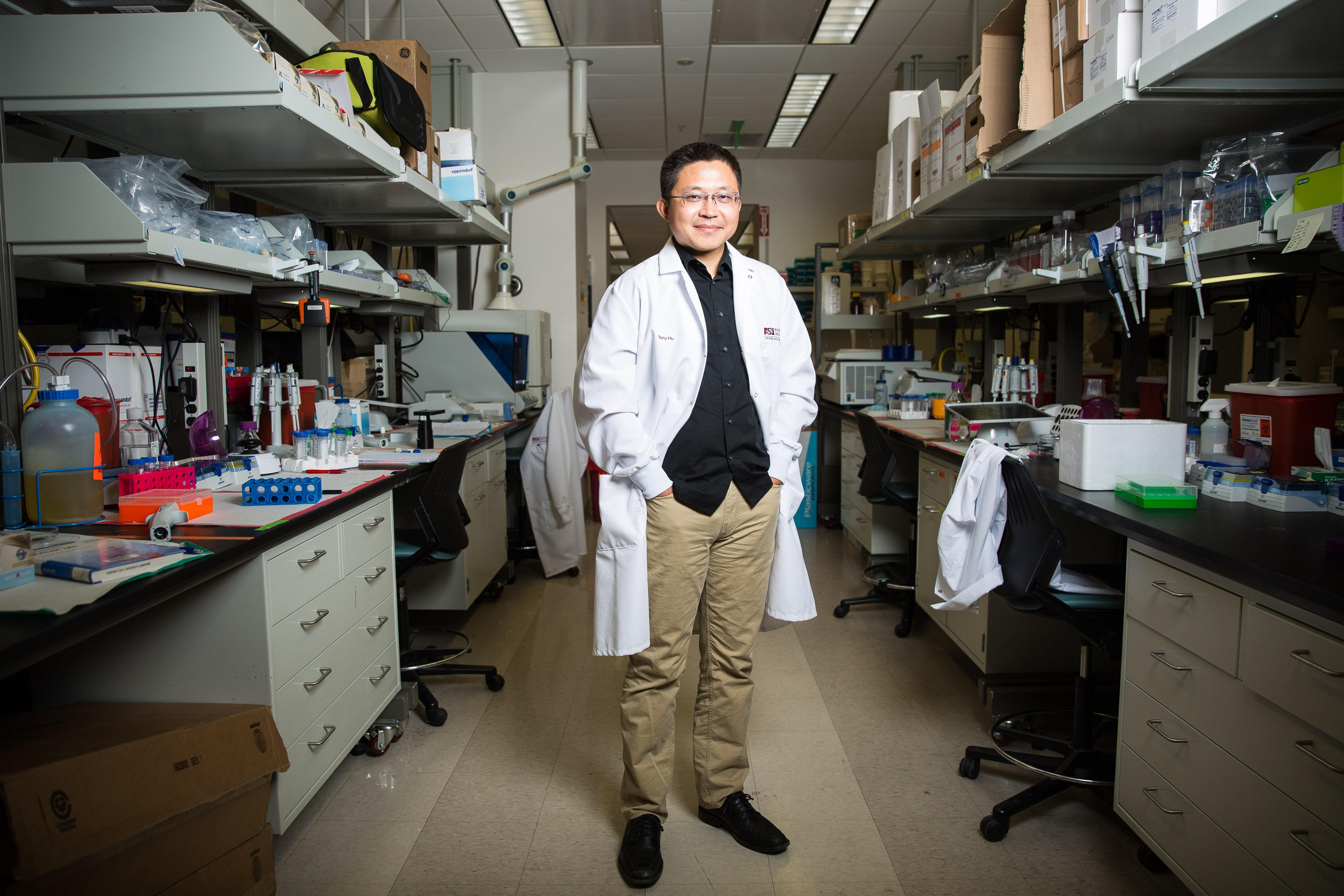Peptides offer fresh insights for cancer diagnosis and treatment
ASU researcher co-edits new book, 'The Enzymes: Peptidomics of Cancer-Derived Enzyme Products'

BRCA1 is a human gene that produces tumor suppressor proteins, which repair damaged DNA and help maintain the stability of each cell’s genetic material. Mutations in this gene (and the related gene BRCA2), can disable this repair network, resulting in an increased risk of breast cancer. In the graphic, tumor-associated proteins resulting from mutations in BRCA1 are degraded into smaller fragments or peptides, which circulate in the bloodstream. These circulating peptides are then enriched using specialized nanoporous silica thin films or NanoTraps, then profiled using mass spectrometry to identify among four clinical groups. Such research may help clinicians determine which carriers of BRCA1 mutations are most likely to progress to breast cancer.
Genes and proteins play essential roles in the maintenance of health and the development of disease and are the focus of the fields of genomics and proteomics, respectively.
Genes, which are composed of 4 nucleic acids, provide the blueprint for constructing all living forms, while proteins, which are composed of some 20 amino acids, are the body’s tireless day laborers, building organs and tissues, forming a complex defense network of antibodies, transporting essential materials to far-flung destinations in the body and facilitating essential chemical reactions.
Less well known are the peptides, though they too are central players in life processes and can shed new light on a variety of diseases. Indeed, the rapidly expanding field of peptide research or peptidomics is poised to deliver fresh biological insights and new methods for the detection and treatment of a broad range of disorders, particularly cancer.
A new book, "The Enzymes: Peptidomics of Cancer-Derived Enzyme Products," explores the peptidome in keen detail. The particular focus of the book is how peptides, small segments of linked amino acids, can provide researchers and clinicians with vital clues about cancer prognosis currently unavailable through conventional diagnostic methods.
Tony Hu, a researcher in Arizona State University's Virginia G. Piper Biodesign Center for Personalized Diagnostics, co-edited the new book.
“Back in 2016, I was invited to UCLA to give a seminar. I talked with a professor there — Fuyuhiko Tamanoi — who served for many years as the editor for the book series 'Enzyme,'” Hu said. “After he heard a bit about emerging peptide research, he decided it would make a fine topic for a new book, so we invited experts worldwide, from Europe, from China, Japan and the U.S. to explore different aspects of the peptidome.”
As Hu explained, the book is divided into three major areas. The first deals with the discovery of biomarkers — peptide signals present in blood or saliva that can be used for diagnostic purposes. The second part deals with peptide biofunction, which turns out to play a critical role in cancer. The third section is devoted to clinical application and regulation of peptide biomarkers. The book therefore spans research on the peptidome reaching from the laboratory bench to the patient bedside, making it the most comprehensive handbook of leading edge peptidomics to date.
Probing the peptidome
Peptides, like proteins, are composed of amino acids. They are generally far smaller molecules, typically composed of just 50 amino acids or less. They are often produced through the breakdown of larger, more complex proteins. This process of protein degradation is a common feature in cancer progression, invasion and metastasis. In the course of these processes, peptide byproducts of the tumor microenvironment circulate in the bloodstream, providing a potentially rich source of biomarkers for disease.
Although there are myriad cancer-specific proteins secreted by active tumors, which could potentially serve as biomarkers, the challenges of monitoring such proteins — particularly in a clinical environment — are often formidable due to fluctuations in their location and abundance. Hu believes that tumor-secreted peptides, which circulate in the blood, can provide an alternate window into underlying activity, providing more fine-grained diagnoses of a given cancer than can be gleaned from either the genes or proteins alone.
ASU researcher Tony Hu's new book, "The Enzymes: Peptidomics of Cancer-Derived Enzyme Products," focuses on the role of peptides in cancer detection and therapy. Photo by Deanna Dent/ASU Now
A new field is born
“About 15 years ago, people started looking at peptides,” Hu said.
Peptides are a rich source of information about the proteins they are derived from and also can shed light on the body’s enzymatic network. As Hu explained, enzymatic activity is often a crucial component in cancer progression, but getting a precise handle on tumor-related enzyme activity has, until recently, proved challenging.
“We published a paper in Clinical Chemistry back in 2014,” Hu said. “There’s an enzyme that is pretty active at the local tumor site in breast cancer. When we profile this enzyme on the tumor tissue, it’s showing this dramatically increased expression compared to normal.”
The enzyme, however, dissolves in the blood and is undetectable. Testing such cancer patients shows blood enzyme levels close to normal.
This presents clinicians with two options: 1) Use a very invasive method to biopsy the tumor tissue in order to profile the enzyme directly, or 2) look at the peptide product produced by the enzyme, which can be profiled directly from the blood. When Hu and colleagues used this approach, they found a variation in peptide expression that precisely matched the enzyme activity at the tumor site. The results encouraged Hu that peptides indeed have much to tell us about underlying disease.
In other cases, the peptide itself is malfunctioning, which may be correlated with tumor progression. Further, peptides can provide vital clues concerning a tumor’s surrounding microenvironment, for example signaling a condition of low oxygen or hypoxia, an important precursor of cancer metastasis and an area of research Hu is currently involved in.
Another critical peptide under study is Hepcidin, a 25-amino acid peptide synthesized in the liver, which serves as the principle regulator of iron metabolism in vertebrates. It can also be used as a telltale indicator of elevated iron status, inflammation and infection associated with diseases including cancer and HIV.
In order to profile peptides from blood samples, mass spectroscopy is used, a technique allowing peptides to be accurately identified based on their molecular weights. Once an exotic technology confined to sophisticated laboratories, cutting-edge mass spec technology is now common in hospital settings around the world, further enabling peptide biomarker discovery to advance and enter routine clinical use.
Finding new avenues
As the authors note, specialized enzymes involved in protein degradation — known as proteases — are involved in all phases of cancer progression including early growth, angiogenesis, inflammation, survival and invasion. Their peptide byproducts offer insights into all of these processes. Evaluation of inflammation through peptide analysis could also be used as a rapid and direct indicator of drug toxicity in chemotherapy, a process that currently must rely on patient symptomatology.
Finally, advances in biotechnology have allowed a new class of safe and efficacious peptide drugs to be developed, furthering the aims of personalized medicine. Immunotherapy, in which the patients’ own immune system is used to attack cancer cells, is just one area where peptides are being applied therapeutically. The immune system responds to a cancer-linked peptide by mounting a robust defense — a technique currently being explored in the fight against prostate cancer.
“For these reasons, we believe peptides have been undervalued for a long time in cancer studies,” Hu said.
Accurate, early diagnostic and prognostic markers are still lacking for most cancers, posing the most significant challenge for successful diagnosis and treatment. Vital information, unavailable through proteomic study, is now becoming accessible through sensitive detection of circulating peptides. The new book throws light on an exciting and hopeful domain of research.
More Science and technology

ASU author puts the fun in preparing for the apocalypse
The idea of an apocalypse was once only the stuff of science fiction — like in “Dawn of the Dead” or “I Am Legend.” However…

Meet student researchers solving real-world challenges
Developing sustainable solar energy solutions, deploying fungi to support soils affected by wildfire, making space education more…

Miss Arizona, computer science major wants to inspire children to combine code and creativity
Editor’s note: This story is part of a series of profiles of notable spring 2024 graduates. “It’s bittersweet.” That’s how…
